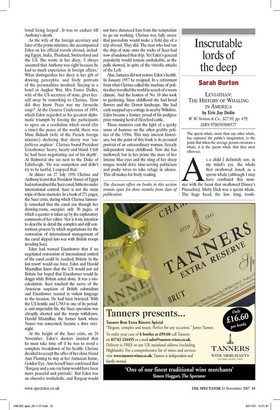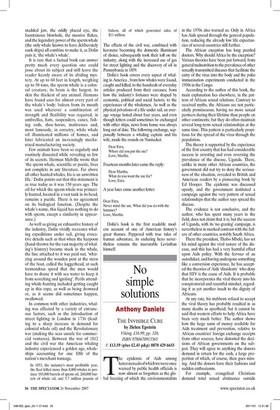Inscrutable lords of the deep
Sarah Burton LEVIATHAN: THE HISTORY OF WHALING IN AMERICA by Eric Jay Dolin W W Norton & Co., $27.95, pp. 479, ISBN 9780393060577 The sperm whale, more than any other whale, has captured the public's imagination, to the point that when the average person envisions a whale, it is the sperm whale that they most often see.
As a child I definitely saw, in my mind's eye, the whale that swallowed Jonah as a sperm whale (although I may have conflated this monster with the beast that swallowed Disney's Pinocchio). Moby Dick was a sperm whale. The huge head, the low, long, toothstudded jaw, the oddly placed eye, the fountainous blowhole, the massive flukes, and the legendary power of the sperm whale (the only whale known to have deliberately sunk ships) all combine to make it, as Dolin puts it, 'the whale's whale'.
It is rare that a factual book can answer pretty much every question one could pose about its subject and still leave the reader keenly aware of its abiding mystery. At up to 60 feet in length, weighing up to 50 tons, the sperm whale is a colossal creature; its brain is the largest, its skin the thickest of any animal. Humans have found uses for almost every part of the whale's body: baleen from its mouth was used wherever a combination of strength and flexibility was required, in umbrellas, hats, suspenders, canes, fishing rods, shoe-horns, mattresses and, most famously, in corsetry, while whale oil illuminated millions of homes, and later lubricated an increasingly mechanised manufacturing society.
Few animals have been so regularly and routinely dissected while revealing so few of its secrets. Herman Melville wrote that 'the sperm whale, scientific or poetic, lives not complete in any literature. Far above all other hunted whales, his is an unwritten life.' Dolin points out that this statement is as true today as it was 150 years ago. The oil for which the sperm whale was primarily hunted, located in a vast tank in its head, remains a puzzle. There is no agreement on its biological function. (Despite the whale's name, this liquid has nothing to do with sperm, except a similarity in appearance.) As well as giving an exhaustive history of the industry, Dolin vividly recreates whaling expeditions under sail, giving evocative details such as that when the harpoon (hand-thrown for the vast majority of whaling's history) became stuck in the whale, the line attached to it was paid out, 'whizzing around the wooden post at the stern of the boat, called the loggerhead, at such tremendous speed that the men would have to douse it with sea water to keep it from scorching and igniting'. Perils attending whale-hunting included getting caught up in this rope, as well as being drowned or, as it seems did sometimes happen, swallowed.
In common with other industries, whaling was affected by a variety of extraneous factors, such as the introduction of street lighting in London in 1736 (leading to a sharp increase in demand for colonial whale oil) and the Revolutionary war (making the seas unsafe for commercial ventures). Between the war of 1812 and the civil war the American whaling industry experienced a golden age, whaleships accounting for one fifth of the nation's merchant tonnage.
In 1853, the industry's most profitable year, the fleet killed more than 8,000 whales to produce 103,000 barrels of sperm oil, 260,000 barrels of whale oil, and 5.7 million pounds of baleen, all of which generated sales of $11 million.
The effects of the civil war, combined with kerosene becoming the domestic illuminant of choice, subsequently took their toll on the industry, along with the increased use of gas for street lighting and the discovery of oil in Pennsylvania in 1859.
Dolin's book covers every aspect of whaling in America, from how whales were found, caught and killed, to the hundreds of everyday articles produced from their carcases; from how the industry's fortunes were shaped by economic, political and social factors, to the experiences of the whalemen. As well as the physical privations of a life under sail, an average voyage lasted about four years, and even though letters could sometimes be exchanged with other ships, news from home was always long out of date. The following exchange, supposedly between a whaling captain and his wife, made the rounds on Nantucket.
Dear Ezra, Where did you put the axe? Love, Martha.
Fourteen months later came the reply: Dear Martha, What do you want the axe for? Love, Ezra.
A year later came another letter: Dear Ezra, Never mind the axe. What did you do with the hammer?
Love, Martha.
Dolin's book is the first readable modem account of one of American history's great themes. Peppered with true tales of human adventure, its enduring hero nevertheless remains the inscrutable Leviathan himself.
in the 1970s also warned us. Only in Africa has Aids spread through the general population, reducing the already low life expectancies of several countries still further.
The African exception has long puzzled doctors. Why should Africa be the exception? Various theories have been put forward, from general malnutrition to the prevalence of other sexually transmitted diseases that facilitate the entry of the virus into the body and the polio immunisation experiments conducted in the 1950s in the Congo.
According to the author of this book, the main explanation lies elsewhere, in the pattern of African sexual relations. Contrary to received myths, the Africans are not particularly promiscuous, having no more sexual partners during their lifetime than people on other continents; but they do often maintain several long-term sexual relationships at the same time. This pattern is particularly propitious for the spread of the virus through the population.
The theory is supported by the experience of the first country that has had considerable success in arresting and even reversing the prevalence of the disease, Uganda. There, unlike in many other African countries, the government did not try to deny the seriousness of the situation, revealed to British and American readers by a pioneering book by Ed Hooper. The epidemic was discussed openly, and the government instituted a campaign against the very pattern of sexual relationships that the author says spread the disease.
The evidence is not conclusive, and the author, who has spent many years in the field, does not claim that it is; but the success of Uganda, with its 'no grazing' campaign, is nevertheless in marked contrast with the failure of other countries, notably South Africa.
There the president, Thabo Mbeki, has set his mind against the viral nature of the disease, and this has had a very harmful effect upon Aids policy. With the fervour of an autodidact, and having undergone something like a conversion experience, he has accepted the theories of Aids 'dissidents' who deny that HIV is the cause of Aids. It is probable that he incorporates the viral theory into his conspiratorial and resentful mindset, regarding it as yet another insult to the dignity of Africans.
At any rate, his stubborn refusal to accept the viral theory has probably resulted in as many deaths as apartheid; but it cannot be said that western efforts to help Africa have been very much better. The author shows how the large sums of money available for Aids treatment and prevention, relative to African countries' foreign exchange receipts from other sources, have distorted the decisions of African governments on the subject. They will agree to anything the donors demand in return for the cash, a large proportion of which, of course, then goes missing. And the donors have their fashions and sudden enthusiasms.
For example, evangelical Christians demand total sexual abstinence outside marriage as the solution, while more liberal donors deny that sexual behaviour has anything whatever to do with the spread of the disease. Between the two of them they manage to develop unworkable solutions, imposed by cash on the recipient nations. Some of the schemes that the author describes would be hilarious were they satirical rather than real.
What is clear from the book is that one solution does not fit all situations. We tend to talk of Africa as if there were no variations within it, or as if all Africans had the same customs and history. Like politics, all preventive medicine is local, at least in its implementation. Unfortunately, aid organisations, even when well-meaning, are insufficiently rooted in the countries in which they find themselves to propose anything other than generic solutions. The one constant of foreign aid is four-wheel-drive vehicles painted white.
The Invisible Cure is not a well-constructed book; it meanders as if there were not quite enough material on the main theme to sustain it. There are a few factual errors; in excoriating British colonial policy, it is wrong to characterise Milton Obote merely as a thug, disastrous as a ruler as he undoubtedly was, and to do so is to miss his wider significance altogether. But this book is an important contribution not only to the literature of Aids but, by implication, to that of development economics.








































































 Previous page
Previous page